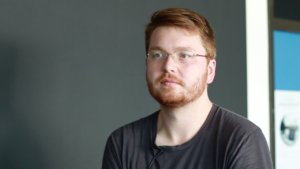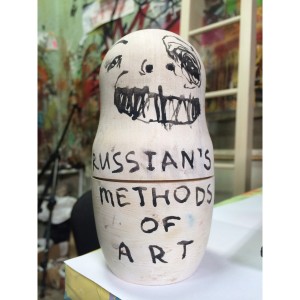First, I have no particular procedure and second, I often work alone… almost always. I have no particular procedure for a reason. I don’t want to promote this, but for me it is important not to make a plan. Instead of having a plan, I try to stay open for input and leave some space to take in anything as long as possible. With the things that I have done and the things that have worked out, I have the experience; I almost never had a fixed plan. For me, things organize themselves. I’ll give you an example, when I worked on my collections of newspaper images, I didn’t plan to collect newspaper pictures. However, I noticed one thing or another and kept them. Little by little, the collection grew and I found connections between the images. At this point, I started to think about it and to arrange the items. I always start thinking about my art quite late. I am not the type for reflection in art production. For me, attention is more important than reflection. That is a core concept for me, now that I think about it. In my opinion not everything has to be done with the intention to make art. My method is to first reduce a lot of the things that could be used. Not to think too much. My method is to get involved with the material I take delight in doing. The pleasure comes with the experience and the surprise of the process. It is also fun to figure out why one tends to certain things and what this means – great experience – and we take it in without thinking about what comes around. You deal with pictures all the time not realizing their impact or what they have to offer, besides the information they hold or what we sense immediately. You can find this in poems. When I read a poem, the poem enters into communication with all the other poems; it has a specific rhythm and sound etc. It is the same with pictures. We use images constantly; often we are touched only by the things we are familiar with and mostly, we are not aware of that. Well, I found pictures interesting if they came to me by themselves. To me, it is necessary to be puzzled by an image, to not be able to explain something in an image, to not understand and to be unsettled by it. It is like a movie scene you do not understand. Images in newspapers are almost always used to illustrate the text. There is no contradiction between an image, a caption or an article. And if a contradiction occurs, you ask yourself, ‚Is it referring to this image?‘ or ‚There is nothing to see in the picture? ‚These are the moments that have always been interesting to me, because I don’t fully understand. Sometimes pictures catch me and then I have to come closer.
Also erstens habe ich kein bestimmtes Vorgehen und zweitens mache ich es häufig alleine, fast immer. Kein bestimmtes Vorgehen habe ich sogar vorsätzlich. Ich spreche jetzt von mir und nicht davon, was ich anderen Leuten rate, sondern das was ich mir selbst rate, nämlich keinen Plan zu machen, nicht mir was vorzunehmen sondern eigentlich möglichst lange in einem Zustand von ‚Dinge aufnehmen‘ zu verbleiben und dem Raum zu geben, dass sich etwas von selbst entwickeln kann. Ich habe die Erfahrung gemacht, bei allem was ich gemacht habe und was später zu etwas geführt hat, eigentlich gar kein Plan im Spiel gewesen ist. Die Dinge haben sich quasi selbst organisiert. Ich geb‘ mal ein Beispiel: Diese Zeitungsbildsammlungen, das war ja nicht so, dass ich da gesessen habe und gesagt habe ‚So, ich sammele jetzt mal Zeitungsbilder, sondern mir ist was aufgefallen und ich habe es aufgehoben und dann ist mir wieder was aufgefallen und ich habe es wieder aufgehoben und dann wuchs das so an und dann habe ich gemerkt, da sehen sich Dinge ähnlich und dann erst habe ich angefangen darüber nachzudenken und die Sachen zu sortieren. Ich denke eigentlich immer erst relativ spät nach. Ich bin gar kein Freund des Nachdenkens bei Kunstproduktionen. Was ich wichtiger finde als Nachdenken ist Aufmerksamkeit. Das ist für mich ein ganz zentraler Begriff, während ich über das was ich tue nachdenke. Meinem Verständnis nach, muss es nicht immer gleich als Kunst gemeint sein. Meine Methode ist eher erst mal sehr Vieles zu verweigern, was man einsetzen könnte. Meine Methode ist, sich auf den Spaß einzulassen. Der Spaß ist das Machen. Der Spaß ist das Erlebnis und die Überraschung daran. Der Spaß ist auch, verstehen zu lernen warum man sich auf bestimmte Dinge zu bewegt und was es bedeutet. Das sind alles tolle Erfahrungen. Und die nimmt man einfach mit, ohne daran zu denken, was es mir bringt. Man geht oft mit Bildern um, ohne sich überhaupt klarzumachen, wie stark sie sind und was sie noch zusätzlich zu bieten haben eben außer Informationen, also außer dem, was wir sofort herauslesen können. Das gibt es auch in Gedichten. Wenn ich ein Gedicht lese, dann kommuniziert das Gedicht auch mit allen anderen Gedichten, die es vorher gab, hat einen Klang etc. Genauso ist das mit Bildern. Aber wir nutzen dauernd Bilder und oft werden nur Seiten in uns angesprochen, die wir uns nicht so bewusst machen. Naja, ich fand Bilder immer dann interessant, wenn sie sich von sich aus auf mich zu bewegt haben. Wenn es eine Szene im Film gab, die ich nicht erklären konnte, im Prinzip ist das ganze nicht erklären können für mich immer so ein Kriterium, wenn etwas verstört oder wenn ich etwas nicht gleich begreife am Bild. Gerade in den Zeitungen, da werden ja Bilder fast immer so eingesetzt, dass sie Texte illustrieren und es überhaupt keinen Widerspruch gibt zwischen einem Bild und einer Bildunterschrift oder dem Artikel. Und wenn es plötzlich passiert, dass sich genau dort eine Lücke auftut und man sich fragt: ‚Ist das jetzt wirklich das gemeinte Bild?’ oder ‚Auf dem Bild ist ja gar nichts zu sehen.’, das sind dann die Momente, die mich immer interessiert haben. Immer da wo ich was nicht verstehe. Dieses Prinzip hat sich bei mir auf viele Bereiche übertragen. Ich bleibe manchmal bei Bildern auch hängen und dann bewege ich mich darauf zu.

















